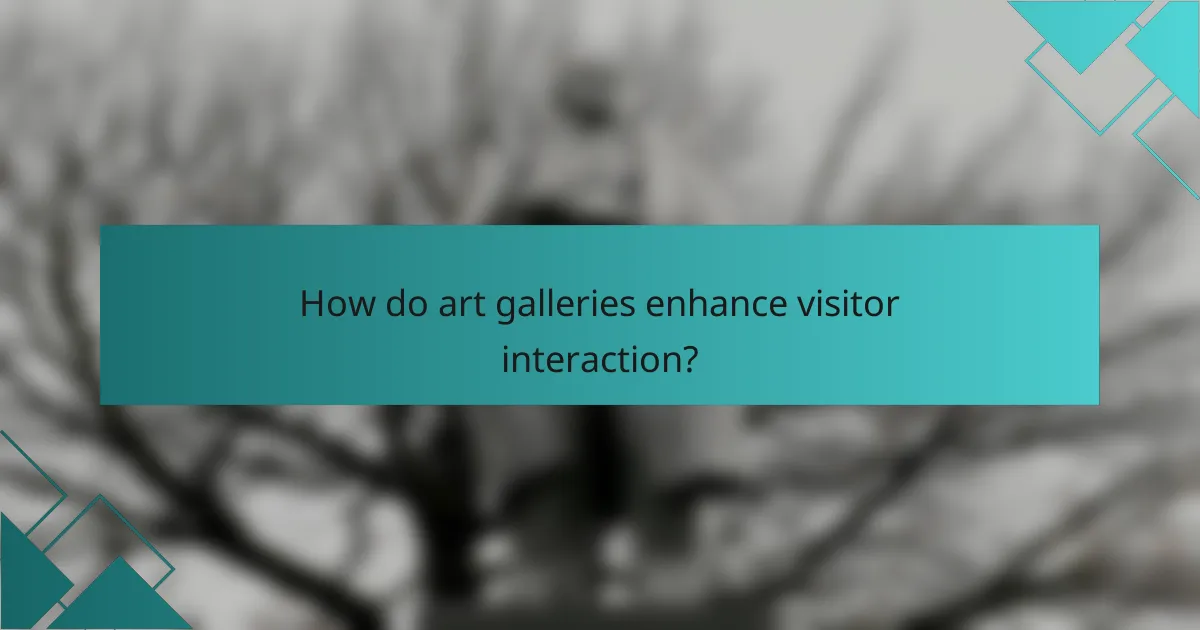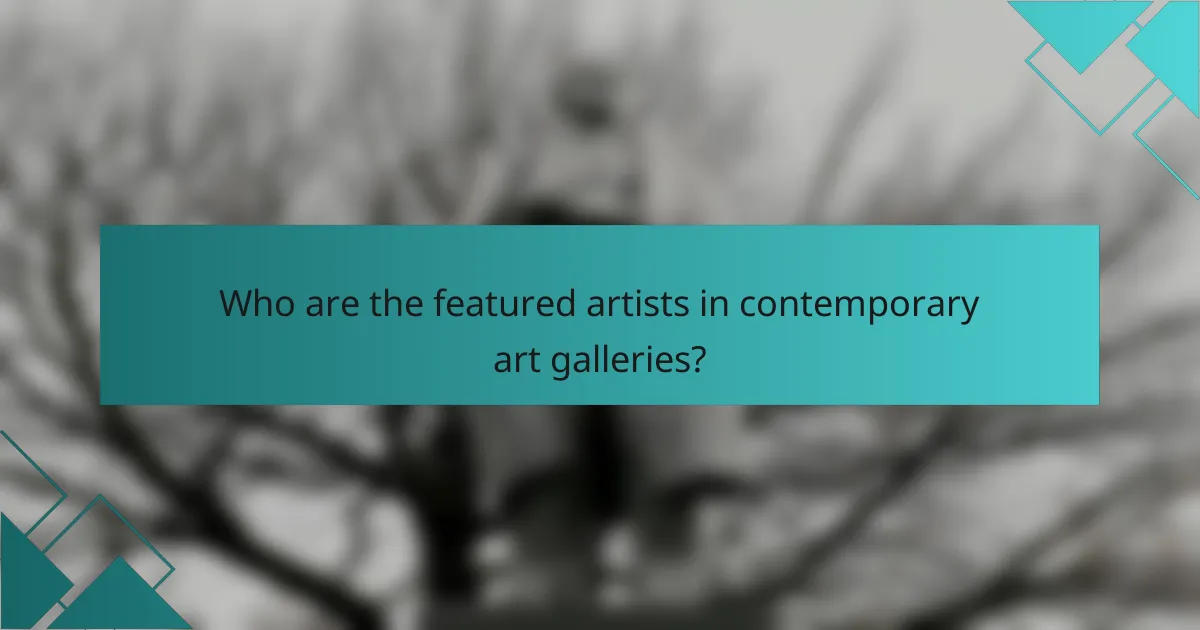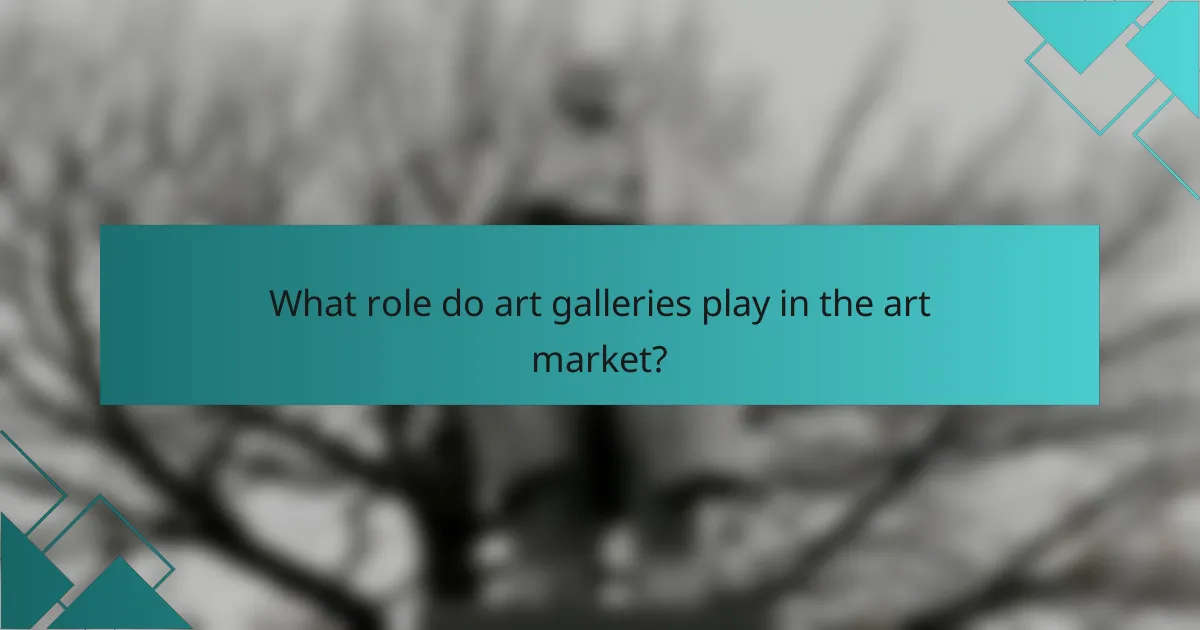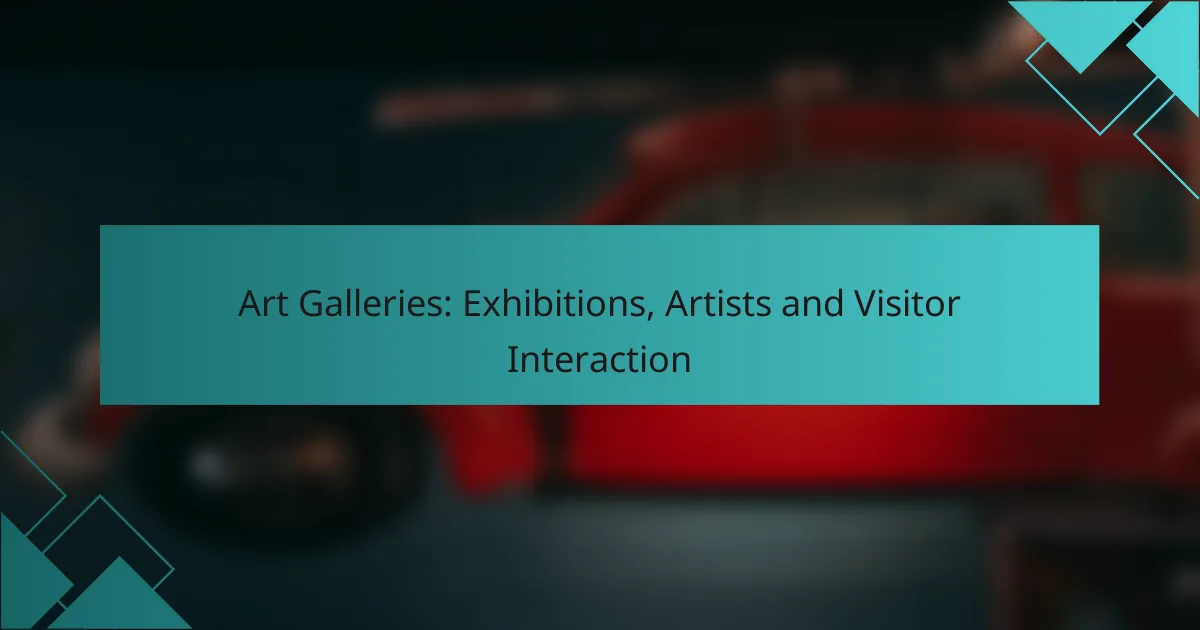Art galleries play a crucial role in enhancing visitor interaction by offering engaging experiences that foster a connection with the artwork. Through interactive exhibitions, guided tours, and workshops, these spaces not only showcase a diverse array of contemporary and historical works but also highlight the creativity of renowned artists, encouraging a deeper appreciation for art and its creators.

How do art galleries enhance visitor interaction?
Art galleries enhance visitor interaction by creating engaging experiences that encourage participation and connection with the artwork. Through various methods such as interactive exhibitions, guided tours, and workshops, galleries foster a deeper appreciation for art and its creators.
Interactive exhibitions
Interactive exhibitions allow visitors to engage directly with the art, often through multimedia installations or hands-on activities. These experiences can include touchscreens, augmented reality features, or even physical interaction with the artwork, making art more accessible and relatable.
For example, some galleries may offer installations where visitors can manipulate elements of the artwork or contribute to a collective piece. This not only enhances engagement but also encourages dialogue among visitors about their interpretations and experiences.
Guided tours
Guided tours provide structured experiences led by knowledgeable guides who share insights about the artists and their works. These tours can vary in length and focus, from brief overviews to in-depth explorations of specific themes or periods in art history.
Participating in a guided tour can significantly enrich the visitor’s understanding, as guides often share anecdotes, historical context, and critical perspectives that may not be evident from the artwork alone. Many galleries offer tours in multiple languages to accommodate diverse audiences.
Workshops and events
Workshops and events hosted by galleries offer hands-on opportunities for visitors to create their own art or learn about specific techniques. These sessions can range from painting and sculpture to photography and digital art, catering to various skill levels.
Additionally, special events such as artist talks, panel discussions, or community art days encourage interaction not only with the art but also with the artists themselves. Engaging in these activities can foster a sense of community and inspire creativity among participants.

What are the current exhibitions in major art galleries?
Major art galleries around the world host a variety of exhibitions that showcase both contemporary and historical works. These exhibitions often feature renowned artists and can include interactive elements for visitor engagement.
The Tate Modern exhibitions
The Tate Modern in London currently features several exhibitions that highlight modern and contemporary art. Notable exhibitions include works by artists such as Yayoi Kusama and a retrospective of the late American artist, Edward Hopper.
Visitors can expect to see immersive installations and thought-provoking pieces that challenge traditional perceptions of art. Tickets are available online, and it is advisable to book in advance, especially for popular exhibitions.
The Louvre exhibitions
The Louvre in Paris is showcasing a range of exhibitions that focus on classical and Renaissance art. Current highlights include a collection of works by Leonardo da Vinci, celebrating his influence on art history.
In addition to the permanent collection, temporary exhibitions often rotate, providing fresh insights into various artistic movements. Entry fees vary, and visitors should check for any special events or guided tours that enhance the experience.

Who are the featured artists in contemporary art galleries?
Contemporary art galleries often showcase a diverse range of artists who push the boundaries of creativity and expression. Among the most notable are Banksy and Yayoi Kusama, both of whom have made significant impacts on the art world with their unique styles and themes.
Banksy
Banksy is an anonymous street artist known for his provocative and politically charged graffiti. His work often addresses social issues, making art accessible to the public and challenging traditional art norms.
Visitors to galleries featuring Banksy’s work can expect to see a blend of humor and irony, often accompanied by social commentary. His pieces, which can range from stenciled images to large murals, invite viewers to reflect on contemporary societal issues.
Yayoi Kusama
Yayoi Kusama is a renowned Japanese artist celebrated for her immersive installations and distinctive polka dot motifs. Her work often explores themes of infinity and self-obliteration, creating a unique experience for viewers.
In galleries, Kusama’s installations, such as her Infinity Mirror Rooms, encourage visitor interaction and engagement. These spaces often feature mirrors and lights that create an illusion of endlessness, captivating audiences and inviting them to contemplate their existence within the universe.

How do art galleries curate their exhibitions?
Art galleries curate their exhibitions by selecting artworks that align with a specific theme or concept, often considering the narrative they wish to convey. This process involves evaluating various factors, including the relevance of the artworks, the artists’ backgrounds, and the intended audience engagement.
Selection criteria
When curating exhibitions, galleries typically use a set of selection criteria to determine which artworks to include. These criteria can include artistic quality, relevance to the theme, and the potential to engage visitors. Curators often look for works that provoke thought or evoke emotion, ensuring a diverse representation of styles and mediums.
Additionally, logistical considerations such as the size and condition of the artworks, as well as the space available in the gallery, play a crucial role in the selection process. Curators may also consider the historical context of the pieces and their significance within the broader art community.
Collaboration with artists
Collaboration with artists is a vital aspect of the curation process. Galleries often work closely with artists to understand their vision and the story behind their works. This collaboration can enhance the exhibition by providing deeper insights into the artworks and fostering a stronger connection with the audience.
Moreover, galleries may involve artists in the installation process, allowing them to influence how their works are displayed. This partnership not only enriches the exhibition experience but also supports artists by promoting their work and expanding their reach within the art community.

What role do art galleries play in the art market?
Art galleries serve as crucial intermediaries in the art market, facilitating the sale of artworks while providing a platform for artists to showcase their work. They help establish pricing, promote artists, and create connections between creators and collectors.
Sales and commissions
Art galleries typically earn revenue through sales commissions, which can range from 30% to 50% of the sale price. This commission structure incentivizes galleries to actively promote and sell the artworks they represent, ensuring that both the gallery and the artist benefit from successful transactions.
When considering a gallery for representation, artists should evaluate the commission rates and the gallery’s track record in selling similar works. It’s also important to understand the terms of the sales agreement, including any additional fees or costs that may apply.
Promotion of emerging artists
Galleries play a vital role in promoting emerging artists by providing them with visibility and access to a broader audience. Through exhibitions, social media, and marketing efforts, galleries help introduce new talent to potential buyers and art enthusiasts.
Emerging artists should seek galleries that align with their artistic vision and have a history of successfully promoting new talent. Participating in group exhibitions or pop-up shows can also be effective ways for artists to gain exposure and build their reputation within the art community.

How can visitors support local art galleries?
Visitors can support local art galleries by engaging with their programs and contributing financially. This can include joining membership programs or participating in fundraising events, both of which help sustain the gallery’s operations and promote local artists.
Membership programs
Joining a membership program is a direct way for visitors to support local art galleries. Memberships often come with benefits such as discounted admission, exclusive previews of exhibitions, and invitations to special events. Fees typically range from affordable monthly contributions to annual memberships, making it accessible for various budgets.
When considering a membership, look for galleries that offer tiered options. Higher tiers may provide additional perks like private tours or merchandise discounts. This can enhance your experience while directly benefiting the gallery.
Participating in fundraising events
Fundraising events are crucial for local art galleries, providing essential funds for exhibitions and community programs. These events can take many forms, including auctions, galas, and art fairs, often featuring local artists and their work. Participation not only supports the gallery financially but also fosters a sense of community.
To get involved, keep an eye on the gallery’s calendar for upcoming events. Consider volunteering your time or donating items for auctions. Engaging in these activities can deepen your connection to the local art scene while contributing to its growth and sustainability.
